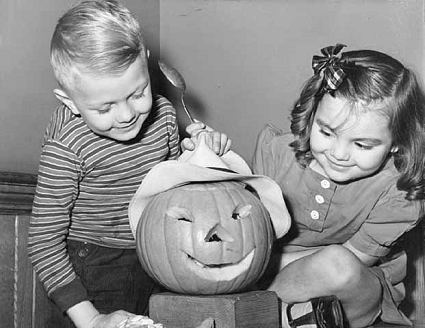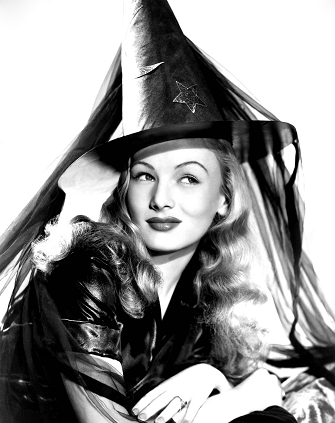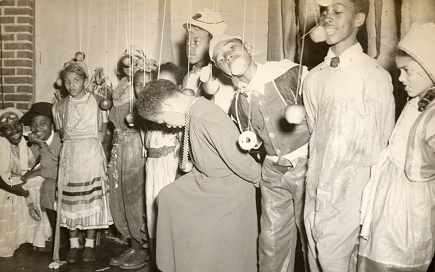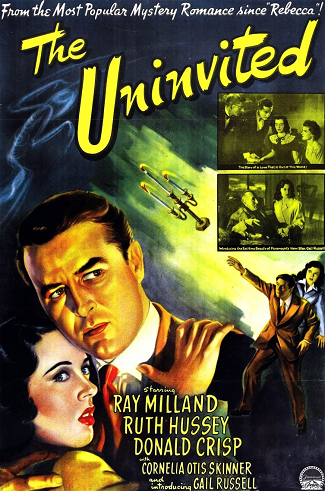Despite the objections of some cities’ grumpiest officials, Halloween fun continued to cheer the hearts of youngsters on World War II’s American home front.
by Carl Zebrowski
“Beheading of the Ghosts” was the name of what the gathered were watching. Armed guards led a victim into a dimly lit chamber and prepared him for the executioner who waited there. “The axeman then raised his axe and as it descended, apparently on the victim’s neck, the lights were extinguished and a resounding whack was heard, followed by a scream,” read an item in the 1940 edition of The Fun Encyclopedia.
The scene was just fun and games, a skit that was part of a Halloween celebration. The would-be victim was acting. But skits like this didn’t seem right when boys were heading overseas to face real deadly weapons. Halloween had to change during the war, and it did.

Halloween festivities in those days focused less on trick-or-treating than they would in the postwar years. That tradition was just coming into its own, and wartime sugar rationing didn’t help. Still, when kids did walk door to door, people gave what they could. “Dressed in makeshift costumes, a bunch of 8-year-olds roamed the neighborhood—a block each evening for three nights until 7:30 p.m. or so…,” recalled Nancy Hoag of her childhood days in Racine, Wisconsin. “We weren’t only given candy but often invited in to visit with the moms and dads whose loved ones were serving our country.”
More typical of Halloween celebrations were town parades and parties, which had grown in popularity through the thirties. In 1939, for example, the City of Newark, New Jersey, had hosted a grand parade featuring 40 large floats. “Police estimate that more than 300,000 persons lined both sides of Broad Street from Lincoln Park to Washington Park, the line of march of the parade,” reported the New York Times.

The effort to keep up traditions like this was enthusiastic, but as the war demanded ever more resources, celebrations had to be scaled back. In some places, volunteer organizations cobbled together what they could to save local events. But some municipalities decided to cancel the holiday outright. “If plans work out, there will not be any Halloween in Chicago,” reported the New York Times on October 15, 1942. “The City Council voted unanimously today to abolish Halloween for the duration….”
Lack of resources wasn’t the only reason for cancellations. Another was to discourage the expanding tradition of Halloween mischief. “Soaping windows isn’t fun this year,” James Spinning, superintendent of schools in Rochester, New York, wrote in 1942. “Your government needs soaps and grease for the war…. Even ringing door bells has lost its appeal because it may be disturbing the sleep of a tired war worker who needs his rest.” By the war’s end, Halloween mischief was on the wane, due to a national mood firmly set against it, with citizens volunteering for neighborhood watches.

Private home parties were the most common events. Magazines and books offered advice for hosting in those war-strapped times. “Spread a few sheaves of corn around the room or stand up some stalks of corn amid a profusion of gay autumn leaves” was one of the tips for decorating with limited supplies that Ethel X. Pastor offered in the 1942 book Wartime Entertaining. Games were a focal point of wartime parties. One of the more popular had blindfolded girls reaching into a bowl to pull out colored cloths–a red one might mean she would marry a soldier; blue, a sailor.
Kids and adults alike showed up in costumes. Clowns, cowboys, and Indians were common. Hobos were everywhere. Witches were, too, modeled on the stereotype Hollywood had recently created in Snow White and the Seven Dwarfs (1937) and Wizard of Oz (1939): hags with pointed hats, long noses, warts, and evil cackles.

The entertainment industry occasionally took up a Halloween theme during the war. In 1944, Ray Milland starred in The Uninvited, the first Hollywood film to focus on ghosts. Released in mid-October, the film established a formula for future haunted house features, climaxing with a scene atop a windy seaside cliff as waves crashed below. On the music side, the Brian Sisters gave Americans “The Boogie Woogieman” in 1942. In a short clip that played on a Panoram (a sort of video jukebox), the three teenagers were dressed like little girls as they sang in mock fear of “the Boogie Woogie Boogie Man” in Andrews Sisters–like harmony.
After the war ended, Halloween began to return to normal. Parades regained their prewar splendor. Candy was plentiful. Parties perked up to their former level of gaiety, with restored license to treat the scary as fun. Of course, the news was not all good: mischief made a comeback, too.
Photos, from top:
• Jimmy Clark and Jeanne Hansel put the finishing touches on their jack-o’-lantern in time for 1942’s Halloween in St. Paul, Minnesota. PHOTO BY ST. PAUL DISPATCH & PIONEER PRESS. MINNESOTA HISTORICAL SOCIETY
• Veronica Lake makes a glamorous sorceress in Paramount Pictures’ 1942 Halloween release I Married a Witch. WWW.DOCTORMACRO.COM
• Kids try to catch apples hanging on strings—using only their teeth, not their hands—in a game at a 1944 Halloween party at the Frederick Douglass Community Center in Washington, DC. PHOTO BY FRANK R. JACKSON. HENRY BAZEMORE COLLECTION OF FREDERICK DOUGLASS DWELLINGS PHOTOGRAPHS, ANACOSTIA COMMUNITY MUSEUM ARCHIVES, SMITHSONIAN INSTITUTION. GIFT OF HENRY BAZEMORE
• The war years had their share of Halloween-appropriate scary movies—like Paramount’s chilling 1944 ghost story The Uninvited, starring Ray Milland and Ruth Hussey.



FOLLOW US »
